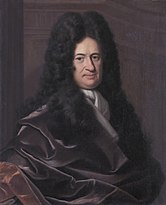Mathematics
| Part of a series on | ||
| Mathematics | ||
|---|---|---|
|
|
||
|
| ||
Mathematics is an area of knowledge that includes the topics of numbers, formulas and related structures, shapes and the spaces in which they are contained, and quantities and their changes. These topics are represented in modern mathematics with the major subdisciplines of number theory,[1] algebra,[2] geometry,[1] and analysis,[3] respectively. There is no general consensus among mathematicians about a common definition for their academic discipline.
Most mathematical activity involves the discovery of properties of
Mathematics is essential in the
Historically, the concept of a proof and its associated
Etymology
The word mathematics comes from
Similarly, one of the two main schools of thought in Pythagoreanism was known as the mathēmatikoi (μαθηματικοί)—which at the time meant "learners" rather than "mathematicians" in the modern sense. The Pythagoreans were likely the first to constrain the use of the word to just the study of arithmetic and geometry. By the time of Aristotle (384–322 BC) this meaning was fully established.[15]
In Latin, and in English until around 1700, the term mathematics more commonly meant "
The apparent
Areas of mathematics
Before the Renaissance, mathematics was divided into two main areas: arithmetic, regarding the manipulation of numbers, and geometry, regarding the study of shapes.[20] Some types of pseudoscience, such as numerology and astrology, were not then clearly distinguished from mathematics.[21]
During the Renaissance, two more areas appeared.
At the end of the 19th century, the
Number theory
Number theory began with the manipulation of numbers, that is, natural numbers and later expanded to integers and rational numbers Number theory was once called arithmetic, but nowadays this term is mostly used for
Many easily stated number problems have solutions that require sophisticated methods, often from across mathematics. A prominent example is
Number theory includes several subareas, including
Geometry
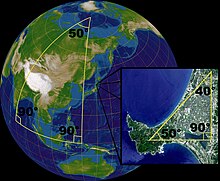
Geometry is one of the oldest branches of mathematics. It started with empirical recipes concerning shapes, such as lines, angles and circles, which were developed mainly for the needs of surveying and architecture, but has since blossomed out into many other subfields.[33]
A fundamental innovation was the ancient Greeks' introduction of the concept of
The resulting
Euclidean geometry was developed without change of methods or scope until the 17th century, when
Analytic geometry allows the study of
In the 19th century, mathematicians discovered
Today's subareas of geometry include:[27]
- parallel linesintersect. This simplifies many aspects of classical geometry by unifying the treatments for intersecting and parallel lines.
- Affine geometry, the study of properties relative to parallelism and independent from the concept of length.
- Differential geometry, the study of curves, surfaces, and their generalizations, which are defined using differentiable functions.
- Manifold theory, the study of shapes that are not necessarily embedded in a larger space.
- Riemannian geometry, the study of distance properties in curved spaces.
- Algebraic geometry, the study of curves, surfaces, and their generalizations, which are defined using polynomials.
- continuous deformations.
- Algebraic topology, the use in topology of algebraic methods, mainly homological algebra.
- Discrete geometry, the study of finite configurations in geometry.
- Convex geometry, the study of convex sets, which takes its importance from its applications in optimization.
- Complex geometry, the geometry obtained by replacing real numbers with complex numbers.
Algebra


Algebra is the art of manipulating
Algebra became an area in its own right only with
Until the 19th century, algebra consisted mainly of the study of
Some types of algebraic structures have useful and often fundamental properties, in many areas of mathematics. Their study became autonomous parts of algebra, and include:[27]
- group theory;
- field theory;
- vector spaces, whose study is essentially the same as linear algebra;
- ring theory;
- commutative algebra, which is the study of commutative rings, includes the study of polynomials, and is a foundational part of algebraic geometry;
- homological algebra;
- Lie algebra and Lie group theory;
- Boolean algebra, which is widely used for the study of the logical structure of computers.
The study of types of algebraic structures as mathematical objects is the purpose of universal algebra and category theory.[46] The latter applies to every mathematical structure (not only algebraic ones). At its origin, it was introduced, together with homological algebra for allowing the algebraic study of non-algebraic objects such as topological spaces; this particular area of application is called algebraic topology.[47]
Calculus and analysis
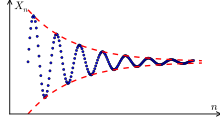
Calculus, formerly called infinitesimal calculus, was introduced independently and simultaneously by 17th-century mathematicians
Presently, "calculus" refers mainly to the elementary part of this theory, and "analysis" is commonly used for advanced parts.Analysis is further subdivided into real analysis, where variables represent real numbers, and complex analysis, where variables represent complex numbers. Analysis includes many subareas shared by other areas of mathematics which include:[27]
- Multivariable calculus
- Functional analysis, where variables represent varying functions;
- ;
- Ordinary differential equations;
- Partial differential equations;
- Numerical analysis, mainly devoted to the computation on computers of solutions of ordinary and partial differential equations that arise in many applications.
Discrete mathematics

Discrete mathematics, broadly speaking, is the study of individual, countable mathematical objects. An example is the set of all integers.[50] Because the objects of study here are discrete, the methods of calculus and mathematical analysis do not directly apply.[d] Algorithms—especially their implementation and computational complexity—play a major role in discrete mathematics.[51]
The
Discrete mathematics includes:[27]
- geometric shapes
- Graph theory and hypergraphs
- error correcting codes and a part of cryptography
- Matroid theory
- Discrete geometry
- Discrete probability distributions
- Game theory (although continuous games are also studied, most common games, such as chess and poker are discrete)
- Discrete optimization, including combinatorial optimization, integer programming, constraint programming
Mathematical logic and set theory
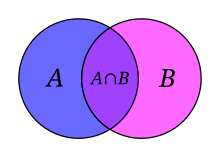
The two subjects of mathematical logic and set theory have belonged to mathematics since the end of the 19th century.[54][55] Before this period, sets were not considered to be mathematical objects, and logic, although used for mathematical proofs, belonged to philosophy and was not specifically studied by mathematicians.[56]
Before
In the same period, various areas of mathematics concluded the former intuitive definitions of the basic mathematical objects were insufficient for ensuring
This became the foundational crisis of mathematics.
The "nature" of the objects defined this way is a philosophical problem that mathematicians leave to philosophers, even if many mathematicians have opinions on this nature, and use their opinion—sometimes called "intuition"—to guide their study and proofs. The approach allows considering "logics" (that is, sets of allowed deducing rules), theorems, proofs, etc. as mathematical objects, and to prove theorems about them. For example, Gödel's incompleteness theorems assert, roughly speaking that, in every consistent formal system that contains the natural numbers, there are theorems that are true (that is provable in a stronger system), but not provable inside the system.[62] This approach to the foundations of mathematics was challenged during the first half of the 20th century by mathematicians led by Brouwer, who promoted intuitionistic logic, which explicitly lacks the law of excluded middle.[63][64]
These problems and debates led to a wide expansion of mathematical logic, with subareas such as model theory (modeling some logical theories inside other theories), proof theory, type theory, computability theory and computational complexity theory.[27] Although these aspects of mathematical logic were introduced before the rise of computers, their use in compiler design, program certification, proof assistants and other aspects of computer science, contributed in turn to the expansion of these logical theories.[65]
Statistics and other decision sciences
The field of statistics is a mathematical application that is employed for the collection and processing of data samples, using procedures based on mathematical methods especially
Computational mathematics
Computational mathematics is the study of
History
Ancient
The history of mathematics is an ever-growing series of abstractions. Evolutionarily speaking, the first abstraction to ever be discovered, one shared by many animals,
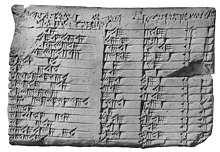
Evidence for more complex mathematics does not appear until around 3000 BC, when the Babylonians and Egyptians began using arithmetic, algebra, and geometry for taxation and other financial calculations, for building and construction, and for astronomy.[76] The oldest mathematical texts from Mesopotamia and Egypt are from 2000 to 1800 BC. Many early texts mention Pythagorean triples and so, by inference, the Pythagorean theorem seems to be the most ancient and widespread mathematical concept after basic arithmetic and geometry. It is in Babylonian mathematics that elementary arithmetic (addition, subtraction, multiplication, and division) first appear in the archaeological record. The Babylonians also possessed a place-value system and used a sexagesimal numeral system which is still in use today for measuring angles and time.[77]
In the 6th century BC, Greek mathematics began to emerge as a distinct discipline and some

The
Medieval and later
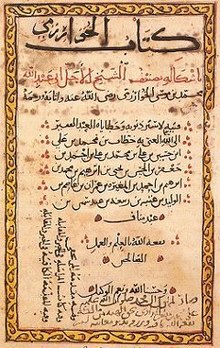
During the
During the early modern period, mathematics began to develop at an accelerating pace in Western Europe, with innovations that revolutionized mathematics, such as the introduction of variables and symbolic notation by François Viète (1540–1603), the introduction of logarithms by John Napier in 1614, which greatly simplified numerical calculations, especially for astronomy and marine navigation, the introduction of coordinates by René Descartes (1596–1650) for reducing geometry to algebra, and the development of calculus by Isaac Newton (1642–1726/27) and Gottfried Leibniz (1646–1716). Leonhard Euler (1707–1783), the most notable mathematician of the 18th century, unified these innovations into a single corpus with a standardized terminology, and completed them with the discovery and the proof of numerous theorems.
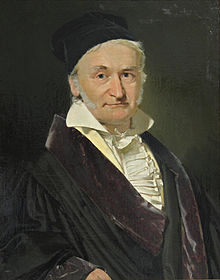
Perhaps the foremost mathematician of the 19th century was the German mathematician Carl Gauss, who made numerous contributions to fields such as algebra, analysis,
Mathematics has since been greatly extended, and there has been a fruitful interaction between mathematics and science, to the benefit of both. Mathematical discoveries continue to be made to this very day. According to Mikhail B. Sevryuk, in the January 2006 issue of the Bulletin of the American Mathematical Society, "The number of papers and books included in the Mathematical Reviews database since 1940 (the first year of operation of MR) is now more than 1.9 million, and more than 75 thousand items are added to the database each year. The overwhelming majority of works in this ocean contain new mathematical theorems and their proofs."[93]
Symbolic notation and terminology
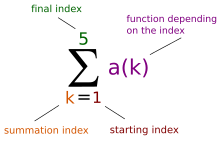
Mathematical notation is widely used in science and
Mathematics has developed a rich terminology covering a broad range of fields that study the properties of various abstract, idealized objects and how they interact. It is based on rigorous
Numerous technical terms used in mathematics are neologisms, such as polynomial and homeomorphism.[99] Other technical terms are words of the common language that are used in an accurate meaning that may differ slightly from their common meaning. For example, in mathematics, "or" means "one, the other or both", while, in common language, it is either ambiguous or means "one or the other but not both" (in mathematics, the latter is called "exclusive or"). Finally, many mathematical terms are common words that are used with a completely different meaning.[100] This may lead to sentences that are correct and true mathematical assertions, but appear to be nonsense to people who do not have the required background. For example, "every free module is flat" and "a field is always a ring".
Relationship with sciences
Mathematics is used in most
There is still a
Pure and applied mathematics
Until the 19th century, the development of mathematics in the West was mainly motivated by the needs of
In the 19th century, mathematicians such as Karl Weierstrass and Richard Dedekind increasingly focused their research on internal problems, that is, pure mathematics.[111][115] This led to split mathematics into pure mathematics and applied mathematics, the latter being often considered as having a lower value among mathematical purists. However, the lines between the two are frequently blurred.[116]
The aftermath of World War II led to a surge in the development of applied mathematics in the US and elsewhere.[117][118] Many of the theories developed for applications were found interesting from the point of view of pure mathematics, and many results of pure mathematics were shown to have applications outside mathematics; in turn, the study of these applications may give new insights on the "pure theory".[119][120]
An example of the first case is the
In the present day, the distinction between pure and applied mathematics is more a question of personal research aim of mathematicians than a division of mathematics into broad areas.[124][125] The Mathematics Subject Classification has a section for "general applied mathematics" but does not mention "pure mathematics".[27] However, these terms are still used in names of some university departments, such as at the Faculty of Mathematics at the University of Cambridge.
Unreasonable effectiveness
The unreasonable effectiveness of mathematics is a phenomenon that was named and first made explicit by physicist Eugene Wigner.[6] It is the fact that many mathematical theories (even the "purest") have applications outside their initial object. These applications may be completely outside their initial area of mathematics, and may concern physical phenomena that were completely unknown when the mathematical theory was introduced.[126] Examples of unexpected applications of mathematical theories can be found in many areas of mathematics.
A notable example is the
In the 19th century, the internal development of geometry (pure mathematics) led to definition and study of non-Euclidean geometries, spaces of dimension higher than three and manifolds. At this time, these concepts seemed totally disconnected from the physical reality, but at the beginning of the 20th century, Albert Einstein developed the theory of relativity that uses fundamentally these concepts. In particular, spacetime of special relativity is a non-Euclidean space of dimension four, and spacetime of general relativity is a (curved) manifold of dimension four.[129][130]
A striking aspect of the interaction between mathematics and physics is when mathematics drives research in physics. This is illustrated by the discoveries of the positron and the baryon In both cases, the equations of the theories had unexplained solutions, which led to conjecture of the existence of an unknown particle, and the search for these particles. In both cases, these particles were discovered a few years later by specific experiments.[131][132][133]
Specific sciences
This subsection is written like a personal reflection, personal essay, or argumentative essay that states a Wikipedia editor's personal feelings or presents an original argument about a topic. (December 2022) |
Physics
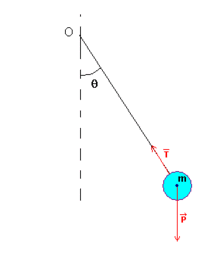
Mathematics and physics have influenced each other over their modern history. Modern physics uses mathematics abundantly,[134] and is also the motivation of major mathematical developments.[135]
Computing
The rise of technology in the 20th century opened the way to a new science: computing.[f] This field is closely related to mathematics in several ways. Theoretical computer science is essentially mathematical in nature. Communication technologies apply branches of mathematics that may be very old (e.g., arithmetic), especially with respect to transmission security, in cryptography and coding theory. Discrete mathematics is useful in many areas of computer science, such as complexity theory, information theory, graph theory, and so on.[citation needed]
In return, computing has also become essential for obtaining new results. This is a group of techniques known as experimental mathematics, which is the use of experimentation to discover mathematical insights.[136] The most well-known example is the four-color theorem, which was proven in 1976 with the help of a computer. This revolutionized traditional mathematics, where the rule was that the mathematician should verify each part of the proof. In 1998, the Kepler conjecture on sphere packing seemed to also be partially proven by computer. An international team had since worked on writing a formal proof; it was finished (and verified) in 2015.[137]
Once written formally, a proof can be verified using a program called a proof assistant.[138] These programs are useful in situations where one is uncertain about a proof's correctness.[138]
A major open problem in theoretical computer science is P versus NP. It is one of the seven Millennium Prize Problems.[139]
Biology and chemistry
Ecology heavily uses modeling to simulate
Genotype evolution can be modeled with the
Phylogeography uses probabilistic models.[citation needed]
Medicine uses
Since the start of the 20th century, chemistry has used computing to model molecules in three dimensions. It turns out that the form of
Earth sciences
Social sciences
Areas of mathematics used in the social sciences include probability/statistics and differential equations. These are used in linguistics, economics, sociology,[146] and psychology.[147]
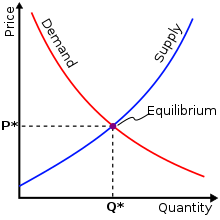
The fundamental postulate of mathematical economics is that of the rational individual actor –
However, many people have rejected or criticized the concept of Homo economicus.
At the start of the 20th century, there was a development to express historical movements in formulas. In 1922,
Even so, mathematization of the social sciences is not without danger. In the controversial book
Relationship with astrology and esotericism
Some renowned mathematicians have also been considered to be renowned astrologists; for example,
Astrology is no longer considered a science.[155]
Philosophy
Reality
The connection between mathematics and material reality has led to philosophical debates since at least the time of
Armand Borel summarized this view of mathematics reality as follows, and provided quotations of G. H. Hardy, Charles Hermite, Henri Poincaré and Albert Einstein that support his views.[131]
Something becomes objective (as opposed to "subjective") as soon as we are convinced that it exists in the minds of others in the same form as it does in ours and that we can think about it and discuss it together.[157] Because the language of mathematics is so precise, it is ideally suited to defining concepts for which such a consensus exists. In my opinion, that is sufficient to provide us with a feeling of an objective existence, of a reality of mathematics ...
Nevertheless, Platonism and the concurrent views on abstraction do not explain the unreasonable effectiveness of mathematics.[158]
Proposed definitions
There is no general consensus about a definition of mathematics or its epistemological status—that is, its place among other human activities.[159][160] A great many professional mathematicians take no interest in a definition of mathematics, or consider it undefinable.[159] There is not even consensus on whether mathematics is an art or a science.[160] Some just say, "mathematics is what mathematicians do".[159] This makes sense, as there is a strong consensus among them about what is mathematics and what is not. Most proposed definitions try to define mathematics by its object of study.[161]
Aristotle defined mathematics as "the science of quantity" and this definition prevailed until the 18th century. However, Aristotle also noted a focus on quantity alone may not distinguish mathematics from sciences like physics; in his view, abstraction and studying quantity as a property "separable in thought" from real instances set mathematics apart.[162] In the 19th century, when mathematicians began to address topics—such as infinite sets—which have no clear-cut relation to physical reality, a variety of new definitions were given.[163] With the large number of new areas of mathematics that appeared since the beginning of the 20th century and continue to appear, defining mathematics by this object of study becomes an impossible task.
Another approach for defining mathematics is to use its methods. So, an area of study can be qualified as mathematics as soon as one can prove theorems—assertions whose validity relies on a proof, that is, a purely-logical deduction.[164] Others take the perspective that mathematics is an investigation of axiomatic set theory, as this study is now a foundational discipline for much of modern mathematics.[165]
Rigor
Mathematical reasoning requires
The concept of rigor in mathematics dates back to ancient Greece, where their society encouraged logical, deductive reasoning. However, this rigorous approach would tend to discourage exploration of new approaches, such as irrational numbers and concepts of infinity. The method of demonstrating rigorous proof was enhanced in the sixteenth century through the use of symbolic notation. In the 18th century, social transition led to mathematicians earning their keep through teaching, which led to more careful thinking about the underlying concepts of mathematics. This produced more rigorous approaches, while transitioning from geometric methods to algebraic and then arithmetic proofs.[9]
At the end of the 19th century, it appeared that the definitions of the basic concepts of mathematics were not accurate enough for avoiding paradoxes (non-Euclidean geometries and Weierstrass function) and contradictions (Russell's paradox). This was solved by the inclusion of axioms with the apodictic inference rules of mathematical theories; the re-introduction of axiomatic method pioneered by the ancient Greeks.[9] It results that "rigor" is no more a relevant concept in mathematics, as a proof is either correct or erroneous, and a "rigorous proof" is simply a pleonasm. Where a special concept of rigor comes into play is in the socialized aspects of a proof, wherein it may be demonstrably refuted by other mathematicians. After a proof has been accepted for many years or even decades, it can then be considered as reliable.[168]
Nevertheless, the concept of "rigor" may remain useful for teaching to beginners what is a mathematical proof.[169]
Training and practice
Education
Mathematics has a remarkable ability to cross cultural boundaries and time periods. As a
Archaeological evidence shows that instruction in mathematics occurred as early as the second millennium BCE in ancient Babylonia.
Following the
During school, mathematical capabilities and positive expectations have a strong association with career interest in the field. Extrinsic factors such as feedback motivation by teachers, parents, and peer groups can influence the level of interest in mathematics.
Psychology (aesthetic, creativity and intuition)
The validity of a mathematical theorem relies only on the rigor of its proof, which could theoretically be done automatically by a
Creativity and rigor are not the only psychological aspects of the activity of mathematicians. Some mathematicians can see their activity as a game, more specifically as solving puzzles.[184] This aspect of mathematical activity is emphasized in recreational mathematics.
Mathematicians can find an
Some feel that to consider mathematics a science is to downplay its artistry and history in the seven traditional
Cultural impact
The examples and perspective in this section deal primarily with Western culture and do not represent a worldwide view of the subject. (December 2022) |
Artistic expression
Notes that sound well together to a Western ear are sounds whose fundamental

Humans, as well as some other animals, find symmetric patterns to be more beautiful.[190] Mathematically, the symmetries of an object form a group known as the symmetry group.[191]
For example, the group underlying mirror symmetry is the cyclic group of two elements, . A
Popularization
Popular mathematics is the act of presenting mathematics without technical terms.[196] Presenting mathematics may be hard since the general public suffers from mathematical anxiety and mathematical objects are highly abstract.[197] However, popular mathematics writing can overcome this by using applications or cultural links.[198] Despite this, mathematics is rarely the topic of popularization in printed or televised media.
Awards and prize problems

The most prestigious award in mathematics is the Fields Medal,[199][200] established in 1936 and awarded every four years (except around World War II) to up to four individuals.[201][202] It is considered the mathematical equivalent of the Nobel Prize.[202]
Other prestigious mathematics awards include:[203]
- The Abel Prize, instituted in 2002[204] and first awarded in 2003[205]
- The Chern Medal for lifetime achievement, introduced in 2009[206] and first awarded in 2010[207]
- The AMS Leroy P. Steele Prize, awarded since 1970[208]
- The Wolf Prize in Mathematics, also for lifetime achievement,[209] instituted in 1978[210]
A famous list of 23 open problems, called "Hilbert's problems", was compiled in 1900 by German mathematician David Hilbert.[211] This list has achieved great celebrity among mathematicians,[212] and, as of 2022[update], at least thirteen of the problems (depending how some are interpreted) have been solved.[211]
A new list of seven important problems, titled the "Millennium Prize Problems", was published in 2000. Only one of them, the Riemann hypothesis, duplicates one of Hilbert's problems. A solution to any of these problems carries a 1 million dollar reward.[213] To date, only one of these problems, the Poincaré conjecture, has been solved.[214]
See also
- List of mathematical jargon
- Lists of mathematicians
- Lists of mathematics topics
- Mathematical constant
- Mathematical sciences
- Mathematics and art
- Mathematics education
- Outline of mathematics
- Philosophy of mathematics
- Relationship between mathematics and physics
- Science, technology, engineering, and mathematics
References
Notes
- ^ Here, algebra is taken in its modern sense, which is, roughly speaking, the art of manipulating formulas.
- better source needed]
- circular cylindersand planes.
- generating series.
- ^ Like other mathematical sciences such as physics and computer science, statistics is an autonomous discipline rather than a branch of applied mathematics. Like research physicists and computer scientists, research statisticians are mathematical scientists. Many statisticians have a degree in mathematics, and some statisticians are also mathematicians.
- ^ Ada Lovelace, in the 1840s, is known for having written the first computer program ever in collaboration with Charles Babbage
- ^ This does not mean to make explicit all inference rules that are used. On the contrary, this is generally impossible, without computers and proof assistants. Even with this modern technology, it may take years of human work for writing down a completely detailed proof.
- ^ This does not mean that empirical evidence and intuition are not needed for choosing the theorems to be proved and to prove them.
- ^ For considering as reliable a large computation occurring in a proof, one generally requires two computations using independent software
- ^ The book containing the complete proof has more than 1,000 pages.
Citations
- ^ a b "Mathematics (noun)". Oxford English Dictionary. Oxford University Press. Retrieved January 17, 2024.
The science of space, number, quantity, and arrangement, whose methods involve logical reasoning and usually the use of symbolic notation, and which includes geometry, arithmetic, algebra, and analysis.
- S2CID 118005003.
Mathematics ... is simply the study of abstract structures, or formal patterns of connectedness.
- OCLC 125397884.
Calculus is the study of change—how things change and how quickly they change.
- OCLC 236026294. Archived (PDF) from the original on November 7, 2022. Retrieved January 17, 2024. (at ResearchGate)
 Archived November 5, 2022, at the Wayback Machine
Archived November 5, 2022, at the Wayback Machine - ^ Peterson 1988, p. 12.
- ^ from the original on February 28, 2011.
- The University of Georgia. Archivedfrom the original on June 1, 2019. Retrieved January 18, 2024.
- S2CID 21629993.
- ^ S2CID 7787171.
- ^ a b Harper, Douglas (March 28, 2019). "Mathematic (n.)". Online Etymology Dictionary. Archived from the original on March 7, 2013. Retrieved January 25, 2024.
- ^ Plato. Republic, Book 6, Section 510c. Archived from the original on February 24, 2021. Retrieved February 2, 2024.
- Clarendon Press. Retrieved February 2, 2024.
- ^ Harper, Douglas (April 20, 2022). "Mathematics (n.)". Online Etymology Dictionary. Retrieved February 2, 2024.
- ^ Harper, Douglas (December 22, 2018). "Mathematical (adj.)". Online Etymology Dictionary. Archived from the original on November 26, 2022. Retrieved January 25, 2024.
- OCLC 1762376.
- OCLC 633018890.
- ^ The Oxford Dictionary of English Etymology, Oxford English Dictionary, sub "mathematics", "mathematic", "mathematics".
- ^ "Maths (Noun)". Oxford English Dictionary. Oxford University Press. Retrieved January 25, 2024.
- ^ "Math (Noun³)". Oxford English Dictionary. Oxford University Press. Archived from the original on April 4, 2020. Retrieved January 25, 2024.
- OCLC 523284.
... mathematics has come down to the present by the two main streams of number and form. The first carried along arithmetic and algebra, the second, geometry.
- OCLC 28115124.
It is unfortunate that two curses of mathematics--Numerology and Astrology were also born with it and have been more acceptable to the masses than mathematics itself.
- OCLC 92013695.
- S2CID 253240718.
- OCLC 2240703.
- ^ a b Warner, Evan. "Splash Talk: The Foundational Crisis of Mathematics" (PDF). Columbia University. Archived from the original (PDF) on March 22, 2023. Retrieved February 3, 2024.
- (PDF) from the original on August 3, 2021. Retrieved February 3, 2024.
The new MSC contains 63 two-digit classifications, 529 three-digit classifications, and 6,006 five-digit classifications.
- ^ a b c d e f g h "MSC2020-Mathematics Subject Classification System" (PDF). zbMath. Associate Editors of Mathematical Reviews and zbMATH. Archived (PDF) from the original on January 2, 2024. Retrieved February 3, 2024.
- S2CID 118560854.
- S2CID 118934517.
- S2CID 117789303.
- S2CID 53319514.
- S2CID 14555830.
- ^ ].
- OCLC 42290188. Retrieved February 7, 2024.
- OCLC 56317813.
- S2CID 117709681. Retrieved February 8, 2024.
- University of St. Andrews. Archivedfrom the original on November 6, 2022. Retrieved February 8, 2024.
- OCLC 213765703.
- S2CID 121346342.
- ^ Kleiner 2007, "History of Classical Algebra" pp. 3–5.
- ^ Lim, Lisa (December 21, 2018). "Where the x we use in algebra came from, and the X in Xmas". South China Morning Post. Archived from the original on December 22, 2018. Retrieved February 8, 2024.
- (PDF) from the original on November 8, 2022. Retrieved February 8, 2024.
- ^ Kleiner 2007, "History of Linear Algebra" pp. 79–101.
- OCLC 51234417. Retrieved February 8, 2024.
- OCLC 647049731. Retrieved February 8, 2024.
- OCLC 85242858. Retrieved February 8, 2024.
- (PDF) from the original on November 9, 2022. Retrieved February 9, 2024.
- ^ O'Connor, J. J.; Robertson, E. F. (September 1998). "Leonhard Euler". MacTutor. Scotland, UK: University of St Andrews. Archived from the original on November 9, 2022. Retrieved February 9, 2024.
- S2CID 6945363. Retrieved February 9, 2024.
- S2CID 67358543. Retrieved February 9, 2024.
- S2CID 19315498. Retrieved February 9, 2024.
- S2CID 11678884.
- ^ Ewald, William (November 17, 2018). "The Emergence of First-Order Logic". Stanford Encyclopedia of Philosophy. Archived from the original on May 12, 2021. Retrieved November 2, 2022.
- ^ Ferreirós, José (June 18, 2020). "The Early Development of Set Theory". Stanford Encyclopedia of Philosophy. Archived from the original on May 12, 2021. Retrieved November 2, 2022.
- (PDF) from the original on February 2, 2023. Retrieved November 11, 2022.
- ^ Wolchover, Natalie (December 3, 2013). "Dispute over Infinity Divides Mathematicians". Scientific American. Archived from the original on November 2, 2022. Retrieved November 1, 2022.
- PhilArchive. Retrieved November 18, 2022.
- ^ Avigad, Jeremy; Reck, Erich H. (December 11, 2001). ""Clarifying the nature of the infinite": the development of metamathematics and proof theory" (PDF). Carnegie Mellon Technical Report CMU-PHIL-120. Archived (PDF) from the original on October 9, 2022. Retrieved November 12, 2022.
- ISBN 978-0-521-28761-6. Retrieved November 12, 2022.
- JSTOR 2689412.
- ^ from the original on November 12, 2022. Retrieved November 12, 2022.
- ^ Moschovakis, Joan (September 4, 2018). "Intuitionistic Logic". Stanford Encyclopedia of Philosophy. Archived from the original on December 16, 2022. Retrieved November 12, 2022.
- .
- Kolaitis, Phokion; Vardi, Moshe; Vianu, Victor (2001). "On the Unusual Effectiveness of Logic in Computer Science" (PDF). Archived(PDF) from the original on March 3, 2021. Retrieved January 15, 2021.
- ^ Rouaud, Mathieu (April 2017) [First published July 2013]. Probability, Statistics and Estimation (PDF). p. 10. Archived (PDF) from the original on October 9, 2022. Retrieved February 13, 2024.
- OCLC 36597731.
- OCLC 6707805.
- ^ Whittle 1994, pp. 10–11, 14–18.
- ^ Marchuk, Gurii Ivanovich (April 2020). "G I Marchuk's plenary: ICM 1970". MacTutor. School of Mathematics and Statistics, University of St Andrews, Scotland. Archived from the original on November 13, 2022. Retrieved November 13, 2022.
- LCCN 91018998. Retrieved November 13, 2022.
- (PDF) from the original on March 7, 2023. Retrieved February 15, 2024.
- S2CID 17414557.
- Wilder, Raymond L.Evolution of Mathematical Concepts; an Elementary Study. passim.
- OCLC 843204342.
- ^ Kline 1990, Chapter 1.
- ^ Boyer 1991, "Mesopotamia" pp. 24–27.
- ISBN 978-0-486-24073-2.
- JSTOR 686258.
- ^ Boyer 1991, "Euclid of Alexandria" p. 119.
- ^ Boyer 1991, "Archimedes of Syracuse" p. 120.
- ^ Boyer 1991, "Archimedes of Syracuse" p. 130.
- ^ Boyer 1991, "Apollonius of Perga" p. 145.
- ^ Boyer 1991, "Greek Trigonometry and Mensuration" p. 162.
- ^ Boyer 1991, "Revival and Decline of Greek Mathematics" p. 180.
- ISBN 978-0-486-65620-5. Retrieved November 14, 2022.
- S2CID 144760421.
- S2CID 190176726.
- OCLC 28723059.
- ^ Faruqi, Yasmeen M. (2006). "Contributions of Islamic scholars to the scientific enterprise". International Education Journal. 7 (4). Shannon Research Press: 391–399. Archived from the original on November 14, 2022. Retrieved November 14, 2022.
- (PDF) from the original on December 17, 2022. Retrieved December 5, 2022.
- JSTOR 2304570.
- ^ Sevryuk 2006, pp. 101–109.
- ^ Wolfram, Stephan (October 2000). Mathematical Notation: Past and Future. MathML and Math on the Web: MathML International Conference 2000, Urbana Champaign, USA. Archived from the original on November 16, 2022. Retrieved February 3, 2024.
- S2CID 228085700.
- ^ Letourneau, Mary; Wright Sharp, Jennifer (October 2017). "AMS Style Guide" (PDF). American Mathematical Society. p. 75. Archived (PDF) from the original on December 8, 2022. Retrieved February 3, 2024.
- (PDF) from the original on November 16, 2022. Retrieved February 3, 2024.
- OCLC 64085024.
- University of St. Andrews. Archivedfrom the original on September 29, 2022. Retrieved February 3, 2024.
- S2CID 125455764.
- ISBN 978-0-8493-8331-1. Retrieved November 16, 2022.
- S2CID 6229200. Retrieved November 17, 2022.
- ^ Frigg, Roman; Hartmann, Stephan (February 4, 2020). "Models in Science". Stanford Encyclopedia of Philosophy. Archived from the original on November 17, 2022. Retrieved November 17, 2022.
- ISBN 978-3-319-72478-2. Retrieved November 17, 2022.
- ^ "The science checklist applied: Mathematics". Understanding Science. University of California, Berkeley. Archived from the original on October 27, 2019. Retrieved October 27, 2019.
- ISBN 978-0-7503-0106-0. Retrieved March 19, 2023.
- ISBN 978-0-7923-1270-3. Retrieved April 5, 2020.
- ISBN 978-0-387-98269-4.
- ISBN 978-0-226-05182-6.
- ^ Pigliucci, Massimo (2014). "Are There 'Other' Ways of Knowing?". Philosophy Now. Archived from the original on May 13, 2020. Retrieved April 6, 2020.
- ^ ISBN 978-3-540-34720-0.
- JSTOR 202372.
- ISBN 978-0-19-921312-2. Retrieved November 18, 2022.
- OCLC 1082226900.
- (PDF) from the original on August 12, 2017. Retrieved November 19, 2022.
- ISBN 978-0-691-17529-4. Retrieved November 19, 2022.
- from the original on November 20, 2022. Retrieved November 20, 2022.
- S2CID 34271623. Retrieved November 20, 2022.
- .
- (PDF) from the original on January 2, 2024. Retrieved November 30, 2022.
- ^ Lützen, J. (2011). "Examples and reflections on the interplay between mathematics and physics in the 19th and 20th century". In Schlote, K. H.; Schneider, M. (eds.). Mathematics meets physics: A contribution to their interaction in the 19th and the first half of the 20th century. Frankfurt am Main: Verlag Harri Deutsch. Archived from the original on March 23, 2023. Retrieved November 19, 2022.
- ^ Marker, Dave (July 1996). "Model theory and exponentiation". Notices of the American Mathematical Society. 43 (7): 753–759. Archived from the original on March 13, 2014. Retrieved November 19, 2022.
- . Retrieved November 19, 2022.
- S2CID 245465895.
- ISBN 978-4-431-55059-4. Retrieved November 20, 2022.
- JSTOR 24110208.
- ^ Wagstaff, Samuel S. Jr. (2021). "History of Integer Factoring" (PDF). In Bos, Joppe W.; Stam, Martijn (eds.). Computational Cryptography, Algorithmic Aspects of Cryptography, A Tribute to AKL. London Mathematical Society Lecture Notes Series 469. Cambridge University Press. pp. 41–77. Archived (PDF) from the original on November 20, 2022. Retrieved November 20, 2022.
- ^ "Curves: Ellipse". MacTutor. School of Mathematics and Statistics, University of St Andrews, Scotland. Archived from the original on October 14, 2022. Retrieved November 20, 2022.
- ^ Mukunth, Vasudevan (September 10, 2015). "Beyond the Surface of Einstein's Relativity Lay a Chimerical Geometry". The Wire. Archived from the original on November 20, 2022. Retrieved November 20, 2022.
- JSTOR 20022840.
- ^ ISSN 1027-488X.
- JSTOR 685207.
- .
- ISBN 978-81-203-4642-0. Retrieved January 3, 2023.
- ^ Atiyah, Michael (1990). On the Work of Edward Witten (PDF). Proceedings of the International Congress of Mathematicians. p. 31. Archived from the original (PDF) on September 28, 2013. Retrieved December 29, 2022.
- ^ Borwein, J.; Borwein, P.; Girgensohn, R.; Parnes, S. (1996). "Conclusion". oldweb.cecm.sfu.ca. Archived from the original on January 21, 2008.
- from the original on December 4, 2020. Retrieved February 25, 2023.
- ^ from the original on December 29, 2022. Retrieved December 29, 2022.
- ^ "P versus NP problem | mathematics". Britannica. Archived from the original on December 6, 2022. Retrieved December 29, 2022.
- ^ (PDF) from the original on March 7, 2023. Retrieved December 29, 2022.
- ^ See for example Anne Laurent, Roland Gamet, Jérôme Pantel, Tendances nouvelles en modélisation pour l'environnement, actes du congrès «Programme environnement, vie et sociétés» 15-17 janvier 1996, CNRS
- ^ Bouleau 1999, pp. 282–283.
- ^ Bouleau 1999, p. 285.
- ^ "1.4: The Lotka-Volterra Predator-Prey Model". Mathematics LibreTexts. January 5, 2022. Archived from the original on December 29, 2022. Retrieved December 29, 2022.
- ^ Bouleau 1999, p. 287.
- ISSN 0360-0572.
- ISBN 978-0-08-097087-5. Retrieved September 30, 2023.
- ^ ISBN 978-1-4008-3736-6. Retrieved January 3, 2023.
- ^ a b c Kim, Oliver W. (May 29, 2014). "Meet Homo Economicus". The Harvard Crimson. Archived from the original on December 29, 2022. Retrieved December 29, 2022.
- ^ "Kondratiev, Nikolai Dmitrievich | Encyclopedia.com". www.encyclopedia.com. Archived from the original on July 1, 2016. Retrieved December 29, 2022.
- ^ "Mathématique de l'histoire-géometrie et cinématique. Lois de Brück. Chronologie géodésique de la Bible., by Charles LAGRANGE et al. | The Online Books Page". onlinebooks.library.upenn.edu.
- ^ "Cliodynamics: a science for predicting the future". ZDNET. Archived from the original on December 29, 2022. Retrieved December 29, 2022.
- OCLC 39605994.
- ISBN 978-2-600-00040-6. Retrieved January 3, 2023.
- ^ "L'astrologie à l'épreuve : ça ne marche pas, ça n'a jamais marché ! / Afis Science – Association française pour l'information scientifique". Afis Science – Association française pour l’information scientifique (in French). Archived from the original on January 29, 2023. Retrieved December 28, 2022.
- ^ Balaguer, Mark (2016). "Platonism in Metaphysics". In Zalta, Edward N. (ed.). The Stanford Encyclopedia of Philosophy (Spring 2016 ed.). Metaphysics Research Lab, Stanford University. Archived from the original on January 30, 2022. Retrieved April 2, 2022.
- S2CID 119887253. 189303; also in Newman, J. R. (1956). The World of Mathematics. Vol. 4. New York: Simon and Schuster. pp. 2348–2364.
- ISBN 978-0-7546-3994-7. Archived(PDF) from the original on August 17, 2023. Retrieved December 5, 2022.
- ^ S2CID 122351146.
- ^ ISBN 978-3-0348-0229-1. Retrieved June 20, 2015.
[I]t is first necessary to ask what is meant by mathematics in general. Illustrious scholars have debated this matter until they were blue in the face, and yet no consensus has been reached about whether mathematics is a natural science, a branch of the humanities, or an art form.
- ISBN 978-3-319-62596-6.
- ISBN 978-0-08-093058-9. Retrieved June 20, 2015.
- ISBN 978-0-8218-2102-2. Retrieved June 20, 2015.
- from the original on March 23, 2023. Retrieved November 25, 2022.
- ^ Strauss, Danie (2011). "Defining mathematics". Acta Academica. 43 (4): 1–28. Retrieved November 25, 2022.
- (PDF) from the original on December 5, 2022. Retrieved November 21, 2022.
- ^ Peterson 1988, p. 4: "A few complain that the computer program can't be verified properly." (in reference to the Haken–Apple proof of the Four Color Theorem)
- ^ Perminov, V. Ya. (1988). "On the Reliability of Mathematical Proofs". Philosophy of Mathematics. 42 (167 (4)). Revue Internationale de Philosophie: 500–508.
- S2CID 149753721.
- ISBN 978-1-5381-4517-3. Retrieved November 29, 2022.
- ISBN 978-0-19-921312-2. Retrieved November 24, 2022.
- ISBN 978-1-4614-9154-5.
- S2CID 126067145.
- ^ Subramarian, F. Indian pedagogy and problem solving in ancient Thamizhakam (PDF). History and Pedagogy of Mathematics conference, July 16–20, 2012. Archived (PDF) from the original on November 28, 2022. Retrieved November 29, 2022.
- ISBN 978-981-256-014-8. Retrieved November 26, 2022.
- JSTOR 2314867.
- S2CID 145507519.
- ISBN 978-1-889938-54-7. Archived(PDF) from the original on November 29, 2022. Retrieved November 29, 2022.
- (PDF) from the original on November 22, 2023. Retrieved November 29, 2022.
- PMID 30123014.
- .
- .
- (PDF) from the original on September 6, 2015. Retrieved November 22, 2022.
- ISBN 978-0-8218-4814-2. Retrieved November 25, 2022.
- .
- doi:10.1090/noti1223.
- ^ See, for example Bertrand Russell's statement "Mathematics, rightly viewed, possesses not only truth, but supreme beauty ..." in his History of Western Philosophy. 1919. p. 60.
- S2CID 220636812.
- S2CID 126119711.
- from the original on December 28, 2022. Retrieved December 29, 2022.
- ^ Hestenes, David (1999). "Symmetry Groups" (PDF). geocalc.clas.asu.edu. Archived (PDF) from the original on January 1, 2023. Retrieved December 29, 2022.
- ISBN 978-1-119-05751-2.
- ISBN 978-1-4008-7434-7.
- ^ Bradley, Larry (2010). "Fractals – Chaos & Fractals". www.stsci.edu. Archived from the original on March 7, 2023. Retrieved December 29, 2022.
- ^ "Self-similarity". math.bu.edu. Archived from the original on March 2, 2023. Retrieved December 29, 2022.
- ^ Kissane, Barry (July 2009). Popular mathematics. 22nd Biennial Conference of The Australian Association of Mathematics Teachers. Fremantle, Western Australia: Australian Association of Mathematics Teachers. pp. 125–126. Archived from the original on March 7, 2023. Retrieved December 29, 2022.
- ISBN 978-1-4613-9435-8. Retrieved January 3, 2023.
- ISBN 978-1-4008-8560-2. Retrieved January 3, 2023.
- ^ Monastyrsky 2001, p. 1: "The Fields Medal is now indisputably the best known and most influential award in mathematics."
- ^ Riehm 2002, pp. 778–782.
- ^ "Fields Medal | International Mathematical Union (IMU)". www.mathunion.org. Archived from the original on December 26, 2018. Retrieved February 21, 2022.
- ^ a b "Fields Medal". Maths History. Archived from the original on March 22, 2019. Retrieved February 21, 2022.
- ^ "Honours/Prizes Index". MacTutor History of Mathematics Archive. Archived from the original on December 17, 2021. Retrieved February 20, 2023.
- ^ "About the Abel Prize". The Abel Prize. Archived from the original on April 14, 2022. Retrieved January 23, 2022.
- ^ "Abel Prize | mathematics award". Encyclopedia Britannica. Archived from the original on January 26, 2020. Retrieved January 23, 2022.
- ^ "Chern Medal Award" (PDF). www.mathunion.org. June 1, 2009. Archived (PDF) from the original on June 17, 2009. Retrieved February 21, 2022.
- ^ "Chern Medal Award". International Mathematical Union (IMU). Archived from the original on August 25, 2010. Retrieved January 23, 2022.
- ^ "The Leroy P Steele Prize of the AMS". School of Mathematics and Statistics, University of St Andrews, Scotland. Archived from the original on November 17, 2022. Retrieved November 17, 2022.
- ISBN 978-981-02-3945-9. Archivedfrom the original on February 21, 2022. Retrieved February 21, 2022.
- ^ "The Wolf Prize". Wolf Foundation. Archived from the original on January 12, 2020. Retrieved January 23, 2022.
- ^ a b "Hilbert's Problems: 23 and Math". Simons Foundation. May 6, 2020. Archived from the original on January 23, 2022. Retrieved January 23, 2022.
- ISBN 978-0-19-508030-8. Retrieved November 29, 2022.
- ^ "The Millennium Prize Problems". Clay Mathematics Institute. Archived from the original on July 3, 2015. Retrieved January 23, 2022.
- ^ "Millennium Problems". Clay Mathematics Institute. Archived from the original on December 20, 2018. Retrieved January 23, 2022.
Sources
- Bouleau, Nicolas (1999). Philosophie des mathématiques et de la modélisation: Du chercheur à l'ingénieur. L'Harmattan. ISBN 978-2-7384-8125-2.
- ISBN 978-0-471-54397-8.
- ISBN 978-0-03-029558-4.
- S2CID 117392219. Retrieved February 8, 2024.
- ISBN 978-0-19-506135-2.
- Monastyrsky, Michael (2001). "Some Trends in Modern Mathematics and the Fields Medal" (PDF). CMS – Notes – de la SMC. 33 (2–3). Canadian Mathematical Society. Archived (PDF) from the original on August 13, 2006. Retrieved July 28, 2006.
- ISBN 978-0-399-16524-5.
A Mind for Numbers.
- JSTOR 2369153. Corrected, expanded, and annotated revision with an 1875 paper by B. Peirce and annotations by his son, C. S. Peirce, of the 1872 lithograph ed. Google Eprint and as an extract, D. Van Nostrand, 1882, Google Eprint. Retrieved November 17, 2020..
- Peterson, Ivars (1988). The Mathematical Tourist: Snapshots of Modern Mathematics. W. H. Freeman and Company. OCLC 17202382.
- ISBN 978-0-415-13548-1.
- Riehm, Carl (August 2002). "The Early History of the Fields Medal" (PDF). Notices of the AMS. 49 (7): 778–782. Archived (PDF) from the original on October 26, 2006. Retrieved October 2, 2006.
- Sevryuk, Mikhail B. (January 2006). "Book Reviews" (PDF). (PDF) from the original on July 23, 2006. Retrieved June 24, 2006.
- ISBN 978-0-471-94829-2. Archivedfrom the original on December 19, 2013.
Further reading
- Benson, Donald C. (1999). The Moment of Proof: Mathematical Epiphanies. Oxford University Press. ISBN 978-0-19-513919-8.
- ISBN 978-0-395-92968-1. Available online(registration required).
- ISBN 978-0-19-510519-3.
- ISBN 978-0-393-04002-9.
- Encyclopaedia of Mathematics. Kluwer Academic Publishers. – A translated and expanded version of a Soviet mathematics encyclopedia, in ten volumes. Also in paperback and on CD-ROM, and online. Archived December 20, 2012, at archive.today.
- Hodgkin, Luke Howard (2005). A History of Mathematics: From Mesopotamia to Modernity. Oxford University Press. ISBN 978-0-19-152383-0.
- ISBN 978-0-486-43268-7.
- ISBN 978-0-933174-65-8.
- ISBN 978-3-253-01702-5.






